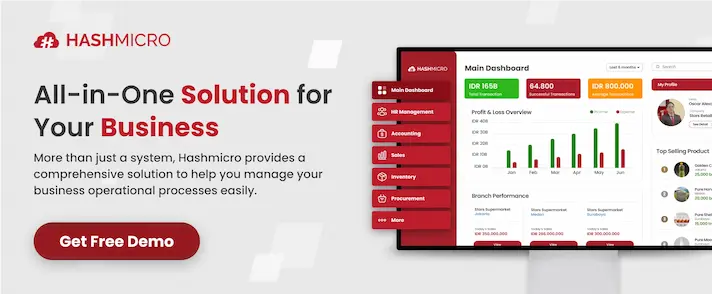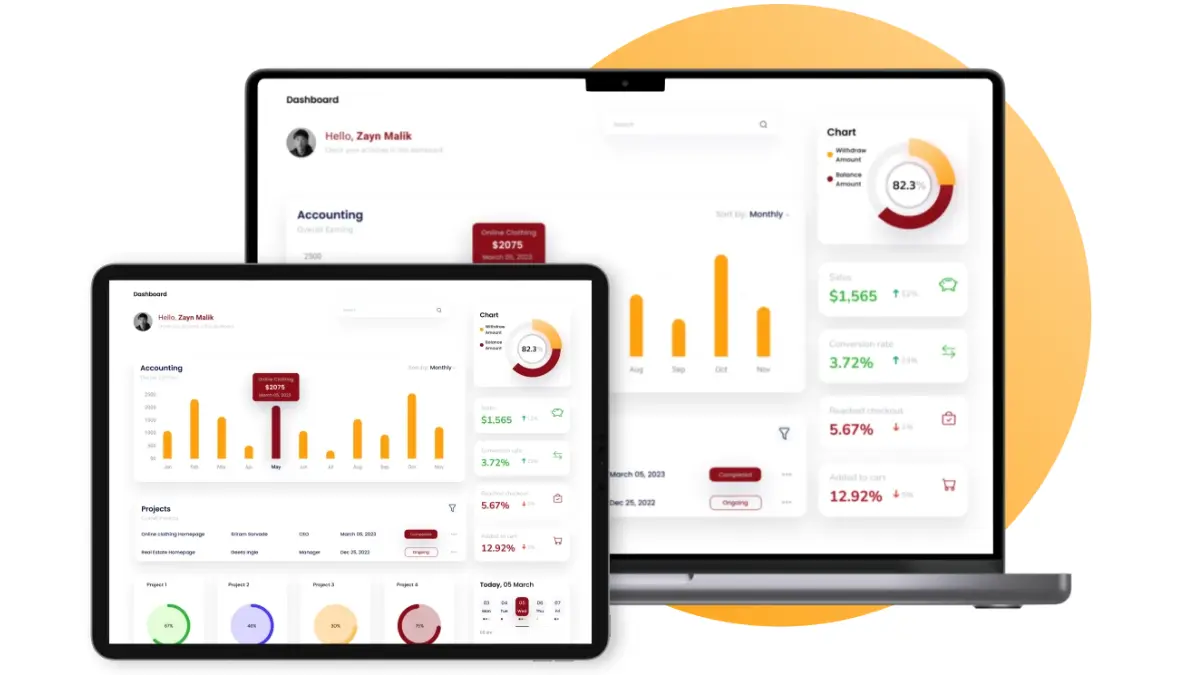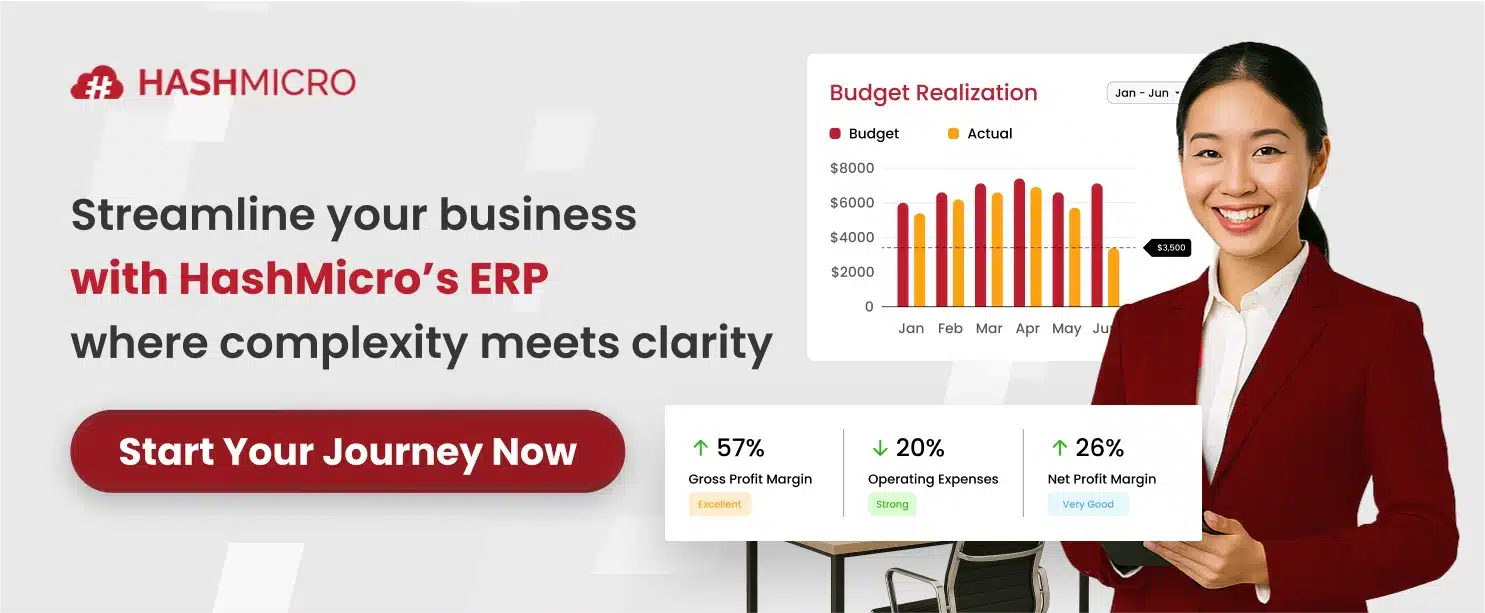ERP implementation is crucial for multinational companies like mine to streamline operations and boost global efficiency. However, without proper planning, challenges such as complex data migration, employee resistance, and misaligned systems.
In fact, the ERP implementation market in Singapore is projected to experience substantial growth, from USD 949.11 million in 2023 to USD 3,455.2 million by 2035, with a CAGR of 12.71%. This shows how vital ERP is for businesses seeking sustainable growth.
That’s why adopting a structured approach and choosing a reliable ERP solution tailored for multinationals is essential. Ready to simplify your global operations? Request a free demo with HashMicro today!

Key Takeaways
|
What is an ERP Implementation?
ERP Implementation is the process of planning, setting up, and launching an ERP system that integrates key business functions, including finance, HR, sales, and manufacturing. This integration boosts productivity and efficiency across the organization, streamlining operations effectively.
To ensure a successful ERP implementation, businesses must first carefully define their specific requirements. This involves identifying how processes need to be redesigned to maximize the benefits of the ERP system and configuring it to support those new workflows.
Navigating this process successfully requires a well-structured, phased approach and rigorous testing before deployment. With careful planning and attention to detail, businesses can unlock the full potential of the best ERP software to enhance productivity and efficiency.
What are the Phases of an ERP Implementation Process?

Implementing an ERP system can be a game-changer for any business, but it requires careful planning to succeed. Before diving into the process, it’s crucial to understand the key phases involved in a typical ERP implementation.
Knowing these stages will help your business navigate the complexities and ensure a smooth transition.
Pre-Implementation
Before any ERP system can be deployed, thorough planning and design are crucial to lay a solid foundation. This phase sets the stage for a successful implementation, ensuring that all requirements and processes are clearly defined.
- Initial discovery & strategic planning
The ERP system implementation journey begins with the discovery and planning phase, which involves researching and selecting a suitable system, assembling a dedicated project team, and defining the system’s detailed requirements.
During this phase, the project team—comprising an executive sponsor, project manager, and representatives from key departments—will develop a project plan, allocate resources, and manage day-to-day tasks.
It’s also essential to involve senior management to ensure adequate support and facilitate organization-wide change. The team may also decide whether to implement an on-premises or cloud-based ERP system.
- Tailored system design
In the design phase, the team works closely with users to develop an optimal design for the new ERP system. This involves creating efficient workflows that capitalize on the system’s capabilities and ensure the business processes are streamlined.
Gap analysis plays a crucial role here, identifying unique business needs that might require customization of the ERP software. Collaborating with the ERP implementation partner ensures the new system aligns with business objectives.
- Custom development & integration
With a clear design in place, the development phase kicks off. This phase focuses on configuring and customizing the software to support the redesigned processes. Integrations with other business applications are also developed during this phase.
This approach prevents unnecessary data clutter and sets up the system for optimal performance post-implementation.
Deployment
With the groundwork in place, it’s time to bring the system to life through careful deployment. This stage focuses on testing, refining, and launching the ERP system to ensure a smooth transition and minimal disruption to business operations.
- Comprehensive testing & refinement
Testing is a critical step in ERP software implementation, often occurring concurrently with development. The project team tests specific modules and features, applies necessary fixes, and conducts retests to ensure the system functions as expected.
Rigorous system testing follows, allowing selected employees to simulate their daily activities within the new ERP system. During this phase, the team also tests data migration accuracy and begins introductory end-user training, which helps familiarize staff with the system before full deployment.
- Seamless deployment
Deployment is when the system goes live, marking the culmination of all prior efforts. Minor issues or user confusion may arise despite thorough preparation, so the project team must be on standby to address questions and resolve any hiccups.
Depending on the strategy, some companies choose to deploy all ERP modules simultaneously, while others take a phased approach, initially focusing on high-priority modules. To minimize risks, some organizations may run legacy systems in parallel during the transition, increasing costs and affecting user productivity.
Post-Implementation
Even after the system goes live, the journey doesn’t end there. Continuous support and improvements are essential to maximize the ERP system’s benefits and adapt to evolving business needs.
- Ongoing support & continuous improvement
Post-deployment support ensures the new ERP system meets business needs and user expectations. During this phase, the project team gathers user feedback, makes necessary adjustments, and potentially adds new features.
Ongoing training is crucial, especially as new employees join the organization. For on-premises ERP systems, periodic software updates and potential hardware upgrades are required, whereas the vendor typically updates cloud-based ERP software automatically, simplifying maintenance.
Implementing an ERP system can be complex, with various ERP implementation challenges at each phase. To simplify your process and get an accurate cost estimate, click the banner below and explore our tailored software pricing.
Challenges in ERP Implementation for Business

Implementing an ERP system can be transformative for a business, but it’s not without its hurdles. Understanding these challenges is crucial to developing a solid strategy for success. By recognizing potential obstacles early, companies can prepare solutions to ensure a smoother and more effective ERP implementation.
- Data migration complexity: Transferring data from existing systems into the new ERP system is a complicated process. It requires extracting, cleaning, and transforming large volumes of data, which, if not managed carefully, can lead to delays and data inconsistencies.
- Cultural diversity: Implementing an ERP system across different regions often involves navigating various cultural norms and work practices. Understanding and respecting these differences are crucial for successful user adoption and to avoid resistance during the ERP implementation process.
- Different business practices across regions: Multinational companies may face challenges aligning diverse business practices into a unified system. To address this, the new ERP system must be flexible enough to accommodate regional variations while maintaining a consistent operational framework.
- Lack of commitment from top management: Successful ERP system implementation requires strong commitment and support from top management. Without their involvement and clear directives, the project may suffer from inadequate resources, delays, and a lack of focus on key objectives.
- Integration issues: Integrating the new ERP system with other existing business applications is often complex and requires meticulous planning. Poor integration can lead to data silos and inconsistencies, disrupting workflows and reducing the overall effectiveness of the ERP software implementation.
- Resistance to change: Employees may hesitate to adopt the new ERP system due to unfamiliarity or fear of altering established processes. Overcoming this resistance involves proactive communication, comprehensive training, and engaging staff throughout the implementation journey to ensure smooth transitions.
ERP Implementation Best Practices

Implementing an ERP system can be transformative for any business, but success depends heavily on following best practices. Without a clear roadmap, companies may encounter obstacles that delay the process and increase costs.
By adopting proven strategies, you can streamline implementation and maximize the benefits of your new ERP system.
- Align ERP goals with organizational objectives: Ensure that the ERP system implementation goals align with your organization’s overall objectives. This alignment guarantees the system will support your strategic priorities.
- Create a comprehensive project management strategy: By regularly comparing progress against the original plan, you can identify areas that need adjustments and ensure the project stays on track.
- Assemble a dedicated and skilled project team: Build an implementation team that includes vital department users who will benefit directly from the new ERP system. Their involvement fosters motivation, as they’ll be eager to realize the system’s benefits and ensure its success.
- Customized training for users: Tailor training sessions to meet the specific needs of different user groups within your organization. Customized training enhances user proficiency, ensuring employees feel confident utilizing the ERP software.
- Find easy-to-implement software: Choosing a straightforward ERP system significantly reduces complexities and project timelines. It makes the transition smoother for your entire team.
With HashMicro ERP Solution, you can find customizable software tailored to your business needs, ensuring a hassle-free implementation. Discover how HashMicro can streamline your operations by providing a user-friendly system.
- Foster open collaboration and communication: Maintain open communication with all stakeholders throughout the ERP implementation process. This approach minimizes misunderstandings and facilitates a smooth transition to the new system.
Integrating these best practices into your ERP system implementation plan sets a strong foundation for a seamless and effective deployment.
Streamline your ERP Implementation Process with Hash Core ERP

HashMicro’s ERP system is one of the best solutions for overcoming the main challenges faced in business today. HashMicro has successfully supported numerous companies in Singapore, helping them streamline operations and enhance productivity.
If you want to learn more about how HashMicro’s ERP can benefit your business, sign up for a free demo today!
HashMicro offers many features covering all business management aspects, ensuring a seamless and efficient workflow. Below are the features provided by Hash Core ERP:
- Built-in BI – Pivot, KPI Scorecard, Custom BI, Dashboard Ninja: Analyzes trends and patterns in large datasets intuitively while monitoring performance using predefined metrics for better decision-making.
- WhatsApp Integration: This integration simplifies and speeds up business communication, enhancing efficiency in various operational processes. It ensures that communication is well-organized.
- Sheet Management: This function efficiently manages and automates spreadsheets or business documents in spreadsheet format. It ensures data security and module integration, enabling more accurate business analysis.
- Access-Level: This feature prevents unauthorized access to critical data by restricting access levels based on employee roles. It also allows managers to monitor all staff activities easily, ensuring data security and transparency.
- AI-Generated Report & Explainer: Generates comprehensive, easy-to-understand reports while providing actionable recommendations. Automatically detects and reports suspicious cost anomalies.
- Mobile Apps Available: This feature supports remote work by allowing employees to connect with the ERP system from anywhere to enhance productivity and flexibility.
- On Cloud / On-Prem – Web ERP: Offers flexible ERP system hosting options, whether through the cloud for ease of access and scalability or on-premise for higher data control and security.
Beyond these features, HashMicro also provides additional benefits, including integration capabilities with other systems and modules. This flexibility allows the ERP system to adapt to your unique business needs, ensuring you maximize your investment.
Conclusion
ERP implementation is crucial for any business seeking to streamline operations, enhance productivity, and maintain a competitive edge. It involves integrating various business processes into a unified system, improving data accuracy and decision-making.
However, choosing the right ERP solution is vital, as the success of this process greatly depends on how well the system aligns with your business needs and goals.
HashMicro’s ERP System is ideal for businesses in Singapore. With its superior features and comprehensive modules, HashMicro offers a highly customizable solution tailored to meet any business’s specific requirements, ensuring a smoother and more effective implementation.
Ready to experience the benefits? Contact us today to try a free demo and see how HashMicro can transform your business operations.

FAQ About ERP Implementation
-
What is the ERP implementation process?
ERP implementation involves planning, configuring or customizing, and deploying the ERP system across the entire organization. To ensure a smooth process, it’s important to engage key stakeholders both before and during the implementation, preparing the business for the upcoming changes.
-
What are the 7 stages of implementation of ERP?
1. Identifying Internal Needs: Evaluate the internal requirements and challenges of your business to ensure the ERP system aligns with organizational goals.
2. Choosing the Right System: Carefully select an ERP system that best fits your company’s specific needs and operational processes.
3. Customizing the System: Design and tailor the ERP system to meet the unique workflows and preferences of your business.
4. System Installation: Implement the ERP software within your company’s infrastructure, ensuring it integrates seamlessly with existing tools.
5. System Testing: Conduct thorough testing to identify and fix any issues before the system goes live, ensuring smooth operations.
6. System Deployment: Launch the ERP system across the organization, making it accessible to all relevant users for daily operations.
7. Ongoing Improvements and Feedback: Continuously enhance the system based on user feedback and evolving business needs to maintain optimal performance. -
What are the main purposes of ERP?
Enterprise Resource Planning (ERP) software helps automate and streamline various activities within a business, including accounting, procurement, project management, customer relationship management, risk management, compliance, and supply chain operations.
-
What is the main focus of ERP?
ERP software is built to automate information sharing, prevent data duplication, ensure data integrity, and support informed decision-making. Overall, it is an advanced, technology-driven system that meets the unique needs of each department, simplifying business management.
































